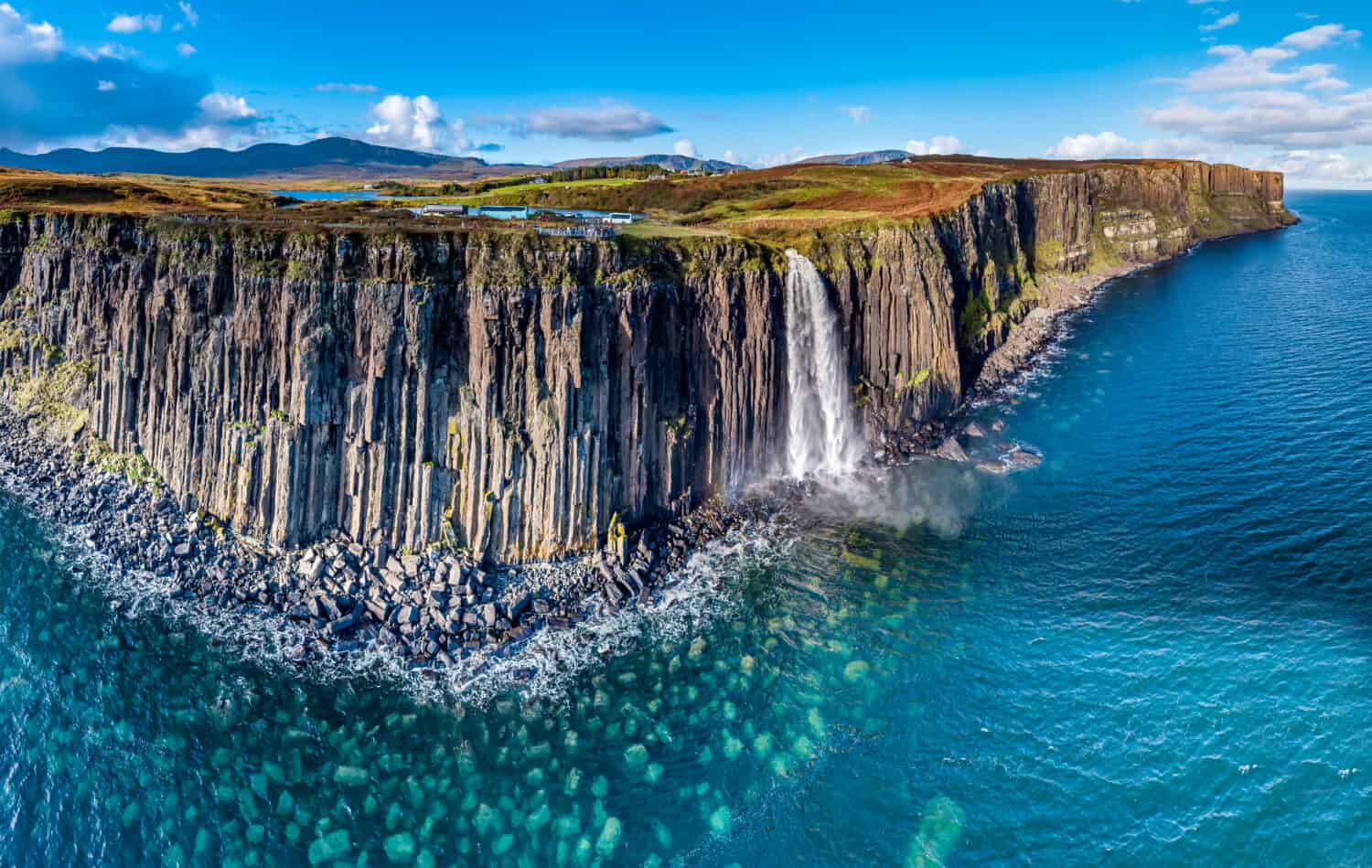Resting off the northwest coast of Scotland is a jewel of an island. The Isle of Skye, which the Norse deemed the “Isle of Mist,” is part of the group of islands that make up the Inner Hebrides archipelago. This gorgeous place has many quaint fishing villages, an impressive castle, and a breathtaking cascading waterfall that empties from a cliff into the ocean.
The sites draw visitors in scores. But even more remarkable is the stunning wildlife that inhabits this misty isle. Golden eagles and white-tailed eagles soar high through its skies, while other fascinating sea birds inhabit its cliffs seasonally like adorable puffins. Majestic red deer roam the Cuillin — a jagged mountain range unique to the island. The waters encircling it are home to all manner of marine life, including seals, whales, and dolphins. You may even catch sight of an otter frolicking in a loch if you’re lucky.
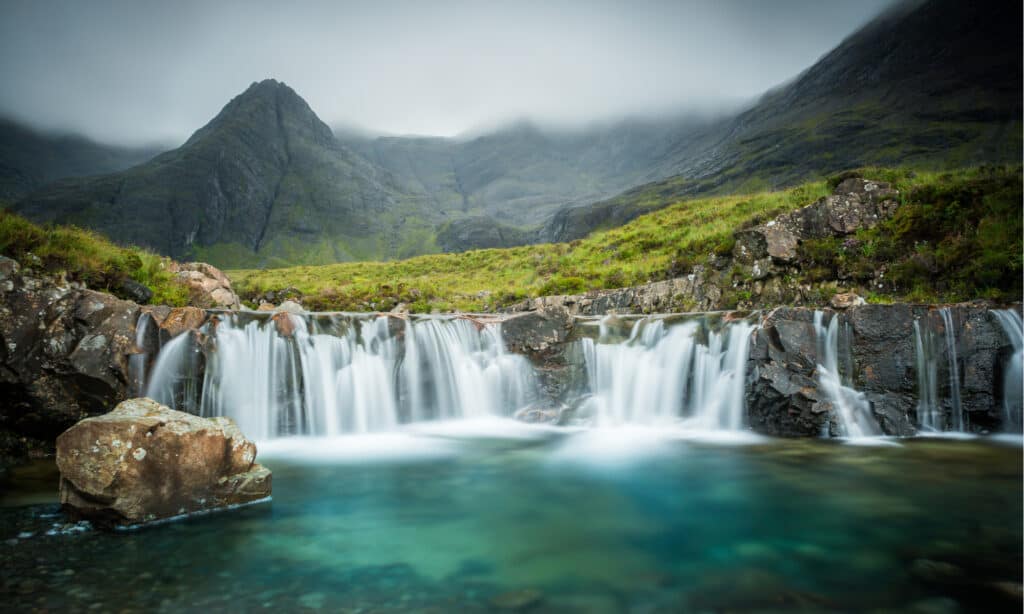
One of the most beautiful sites on the Isle of Skye is the Fairy Pools, located in Glen Brittle.
©orxy/Shutterstock.com
Join us on a journey of exploration to learn not only about the sights and history of this magical place but all about the incredible wildlife on the mystical Isle of Skye.
Location and Topography of the Isle of Skye
The village of Kyle of Lochalsh separates from the Scottish mainland the Isle of Skye, which is the largest island in the Inner Hebrides. Reaching the island is as easy as a drive on the Skye Bridge, which crosses the narrow strip of sea. Other, smaller islands to the south in the Inner Hebrides include Rum, Canna, Eigg, and Muck.
The Isle of Skye has an illustrious reputation for its wild rugged beauty. Rolling hills, jagged cliffs, pristine lochs, and the majestic Cuilin mountain range are all features of the unforgettable landscape that make it a popular travel destination for tourists year-round.
Notable natural sights that draw visitors include:
- The Old Man of Storr: A massive rock formation that juts high above the Rotternish Ridge, affording breathtaking views.
- Quiraing: A geological wonder in the northern part of the island featuring cliffs and interesting rock formations, viewed from a scenic winding road.
- Neist Point: Situated on the west coast of the island where rugged cliffs abound, this area provides the perfect place to view breeding seabirds like kittiwakes, fulmars, guillemots, razorbills, and gannets.
- Fairy Pools: This series of clear, turquoise-colored waterfalls and pools, located in Glen Brittle, are popular with hikers and photographers.
- Kilt Rock and Mealt Falls: The cliff rocks in this breathtaking spot resemble a pleated kilt, while Mealt Falls cascade from a height of 180 feet into the sea below.
- Coral Beach: This gorgeous white beach snuggles up to pristine blue water, offering a great place to walk or swim (if you can stand the frigid chill).
- Fairy Glen: We all know that fairies abound in Scotland, and surely some of them congregate in this magical spot featuring lush green grass and small, conical hills.
Famous Historical Sites
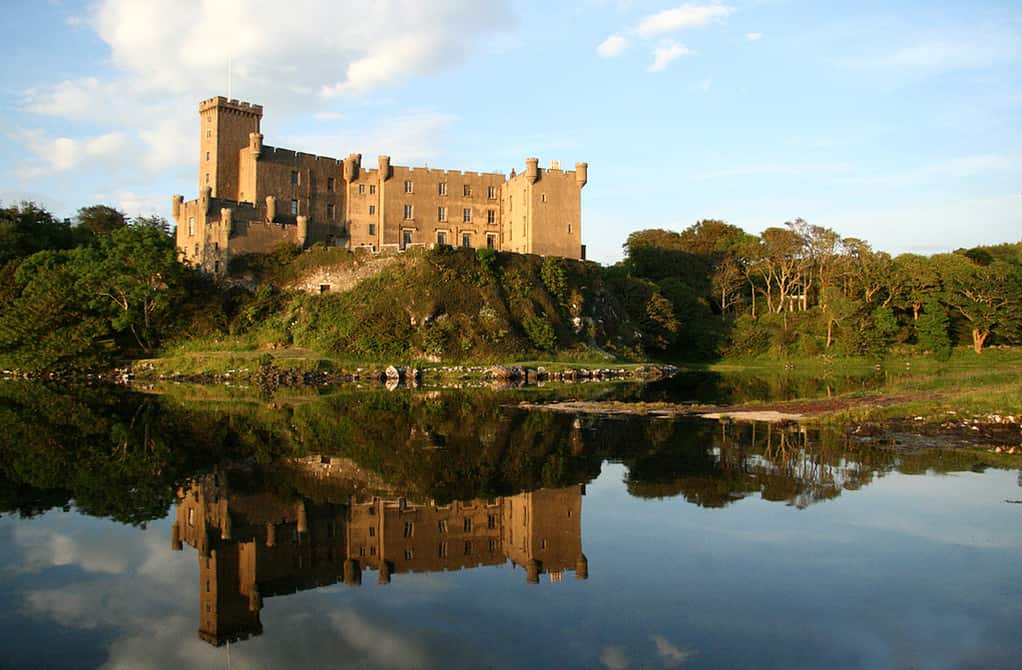
Dunvegan Castle is one of the best historical sites to visit on the Isle of Skye.
The history of human occupation on the Isle of Skye dates back thousands of years to the Mesolithic era. Centuries have seen Celtic tribes, Norse invaders, and Scottish clans inhabit its wild terrain. In the 13th century, Clan MacDonald and Clan MacLeod ruled Skye. These clans often clashed in their desires to control the island.
Ancient monuments that came about from this period include Dunvegan Castle, which has been the seat of Clan MacLeod since its construction in the 13th century. Another is Armadale Castle, once inhabited by Clan MacDonald of Sleat, a branch of Clan MacDonald. Other castle ruins on the Isle of Skye were once MacDonald strongholds — Dunscaith Castle and Knock Castle.

The quaint town of Portree is the capital of the Isle of Skye.
While the MacDonald structures didn’t stand the test of time, Lord MacDonald founded a fishing village 200 years ago that he named Portree, believed to mean “King’s Port” because of a visit by King James V (father of Mary Queen of Scots) in 1540. This picturesque town, located on the east side of Skye, is now the island’s capital.
Wildlife on the Isle of Skye
There’s an array of wildlife that one can observe in the mountains, valleys, cliffs, and lochs on the Isle of Skye. Let’s explore!
Red Deer

Red deer are Scotland’s largest land mammal and an abundant inhabitant of the Isle of Skye.
©iStock.com/JMrocek
Scotland’s largest land mammal is red deer (Cervus elaphus). Herds of these regal animals graze in open moorlands, forests, and grassy hillsides, usually at higher elevations in warm months. They make a winter migration to lower altitudes for food in harsher winter months. Red deer are herbivorous, feeding on grasses, lichens, mosses, herbs, shrubs, leaves, and berries (or other available fruits).
Male red deer (stags) are impressive with their massive antlers, which they shed yearly, growing a new set in spring that will fully develop by summer, in preparation for the rutting season in autumn. Stags use their antlers as weapons to challenge other males for territorial dominance, all while competing for the attention of the females (hinds) that they hope to mate with. Only during the rutting season do males and females congregate together. Otherwise, they dwell in separate herds for most of the year.
These imposing stags can grow from 4.3 to 4.6 feet tall in shoulder height, weighing from 350 to 600 pounds. The hinds reach from 3.6 to 4 feet and weigh in at 150 to 260 pounds. Their average lifespan is from 10 to 15 years, with some reaching 20 years. Natural predators of red deer are golden eagles and white-tailed eagles, surprisingly. These powerful birds of prey can threaten fawns or deer that are weak.
Pine Martens
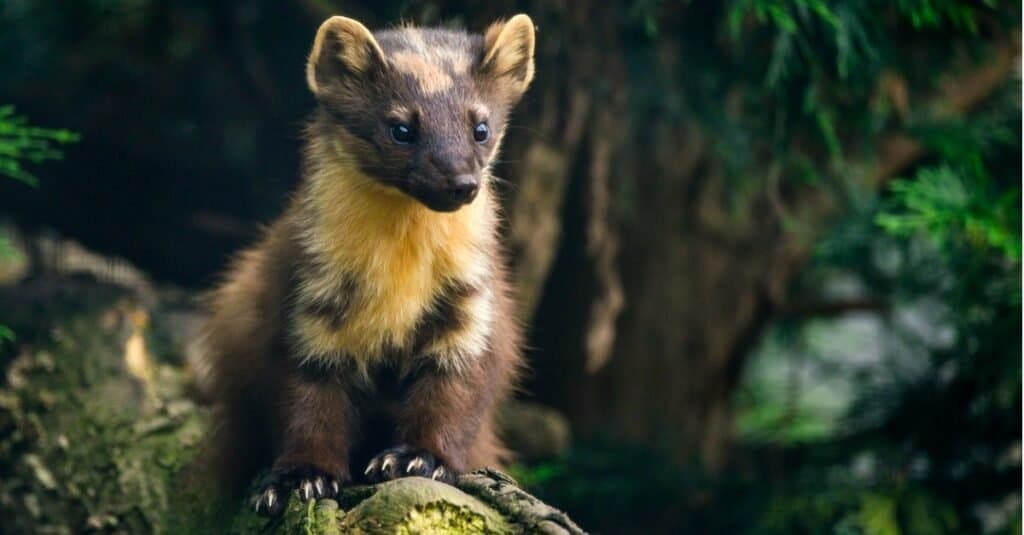
Pine martens are a protected species on the Isle of Skye.
©iStock.com/Matt_Gibson
In stark contrast to the sizable red deer, there’s a small member of the weasel family that also calls the Isle of Skye its home — the pine marten (Martes martes). These cute little critters, no larger than domestic cats, inhabit forests, woodlands, and moorlands. You may be hard-pressed to spot one, as they are nocturnal animals, preferring to hunt for mice, squirrels, small birds, frogs, and insects under a cloak of darkness.
At one time, Scotland was abundant in pine martens, but they suffered from heavy hunting and habitat loss till their numbers dwindled. Conservation efforts in places like the Isle of Skye, where they are a protected species, have helped with population recovery. With this protection, pine martens in the wild can live up to 11 years, though their average lifespan is 3-4 years.
European Otters

You can find European otters in areas like Milovaig or Glendale on the Isle of Skye.
©iStock.com/edevansuk
A close cousin to the pine marten in the Mustelidae family is the European otter (Lutra lutra), a semi-aquatic mammal that resides in freshwater and marine habitats on the Isle of Skye. Also similar to pine martens, otters are elusive nocturnal creatures, but the persistent wildlife observer has the possibility to spot them in areas around Skye like Milovaig, where they fish in Loch Pooltiel, or on the west coast in the area of Glendale.
European otters are characterized by streamlined bodies, tapered tails, and webbed feet that make them excellent swimmers. Their main diet consists of fish like trout, salmon, and eels. These adorable, playful animals inhabit dens of their own making called “holts,” which are underground burrows that protect them from predators and harsh weather. Otters can live an average of 8 to 12 years in the wild.
Golden Eagles
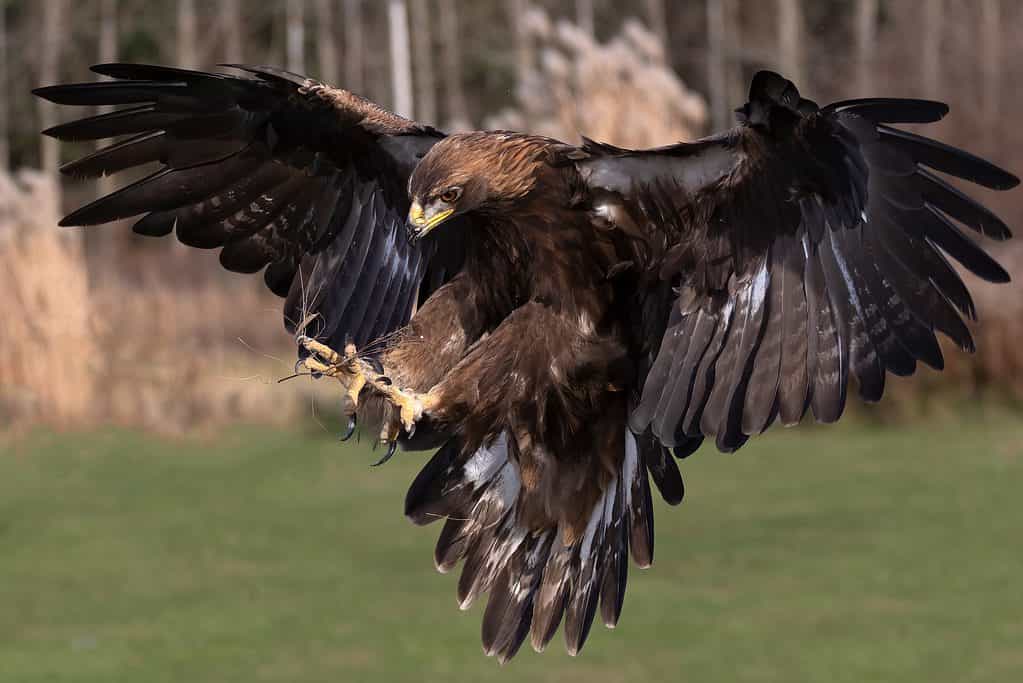
Golden eagles are skilled hunters that prey on hares, rabbits, fowl, and even livestock, like lambs.
©Touched by light images/Shutterstock.com
The Isle of Skye is home to two majestic raptors, one being the superb golden eagle (Aquila chrysaetos). Birdwatchers can spot these protected birds of prey soaring in the skies over the Cuillin mountains. They build huge nests, called “eyries,” in high elevations, and they breed in monogamous pairs. These imposing hunters prey on hares, rabbits, rodents, fowl like grouse, and on some occasions, small livestock like defenseless lambs.
Golden eagles get their name from their dark brown plumage and golden or light-colored heads and necks. They have a wingspan that ranges from 6.7 to 7.9 feet, measuring 2.3 to 3.3 feet in length. These robust birds can survive from 20 to 30 years, while some have been known to live longer.
White-Tailed Eagles

The
white-tailed eagle
is the largest bird of prey in the United Kingdom.
©iStock.com/Dgwildlife
The white-tailed eagle (Haliaeetus albicilla), another inhabitant of the Isle of Skye, is also referred to as a sea eagle. It’s the largest bird of prey in all of the United Kingdom and frequents coastlines and large bodies of water. Its staple diet is fish like salmon or trout, which it snatches from rivers, lakes, and coastal waters, but this predator will also eat rabbits, hares, or birds.
The wingspan of a white-tailed eagle ranges from 6.5 to 8 feet, while its body length can measure 28 to 37 inches. This massive raptor is notable for its characteristic white tail; pale head; large, powerful beak; and piercing yellow eyes. Like golden eagles, white-tailed eagles have long lifespans averaging 20 to 25 years.
Highland Cattle

Long shaggy coats distinguish highland cattle.
©attilio pregnolato/Shutterstock.com
Highland cattle are larger domestic inhabitants that graze in the lush greenery on the Isle of Skye. Nicknamed “hairy coos,” they are known for their long horns that curve upward or forward and long, shaggy coats that offer excellent protection from harsh elements. Being one of the most attractive cattle breeds in the world, these beasts are a favorite among tourists seeking wildlife sightings.
Adult bulls typically weigh from 1,500 to 2,200 pounds, a medium size in the cattle world. Females average 900 to 1,300 pounds. Shoulder height ranges from 3.6 to 4.2 feet. Highland cattle enjoy a long lifespan of 15 to 20 years.
Red-Billed Choughs
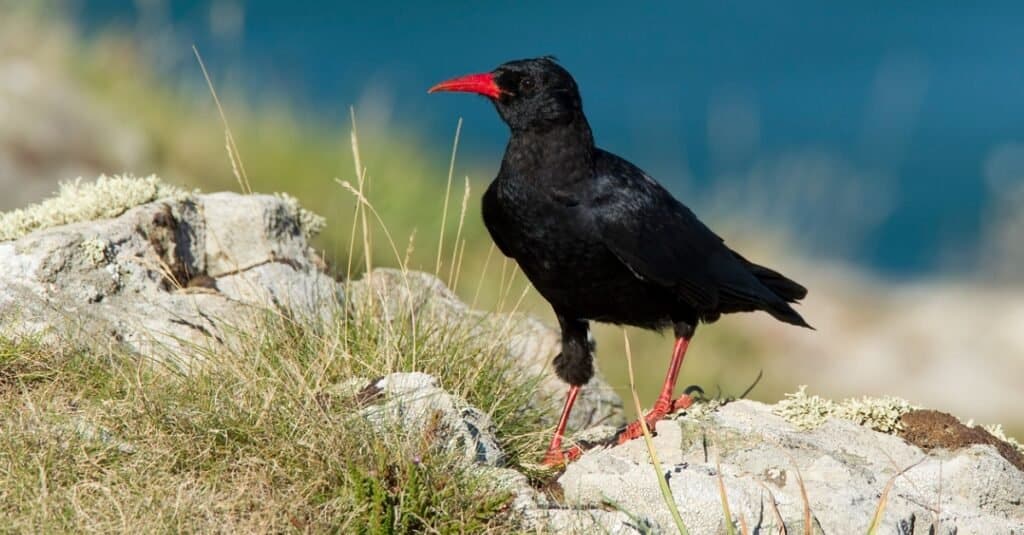
The red-billed chough uses tools to break open a shell.
©iStock.com/birdsonline
Red-billed choughs (Pyrrhocorax pyrrhocorax) can be found nesting in sea cliffs and rugged terrain in areas of the Isle of Skye, like the Storr, the Quiraing, and Loch Coruisk. These mid-sized birds sport glossy black feathers, red legs, and curved red bills. They have distinctive calls and superior aerial acrobatics skills. They were kept as pets in Cornwall in the past and gained a reputation for stealing and hiding inanimate objects. Some birds swiped flammable items like bits of firebrands or candles and hid them in thatch or stacks of corn, which caught fire. This earned them the meaning of their scientific name: ”fire-raven.”
These omnivorous birds consume small mammals and invertebrates, insects, seeds, and berries. Their average lifespan ranges from 5 to 10 years. Predators that can cut that number down to size include the resident raptors on Skye–golden and white-tailed eagles.
Puffins
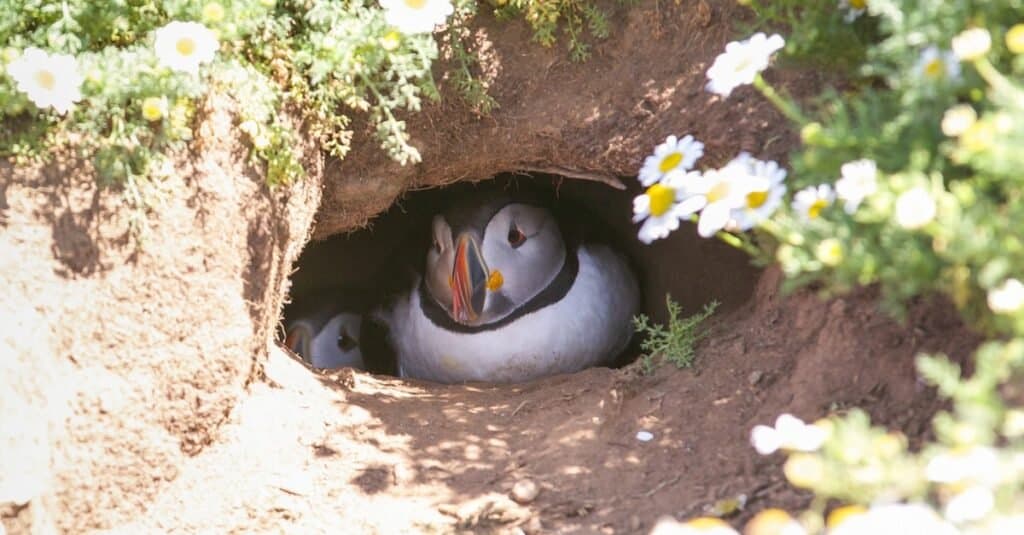
Colonies of puffins breed from April to August on the Isle of Skye, nesting in burrows.
©iStock.com/Henfaes
During the breeding season, typically from April to August, it’s entirely possible to see puffins (Fratercula arctica) nesting in the coastal cliffs on the Isle of Skye. Famous for their tuxedo-like plumage, orange webbed feet, and stand-out colorful beaks, these lovable sea birds frequent certain areas like Staffin Bay, the Trotternish Peninsula, the Isle of Raasay, and Neist Point.
Puffins are talented divers and actually utilize their wings to fly underwater as well as above. Their specialized beaks aid them in fishing for herring, sand eels, and sprats to nourish themselves and their young, who wait patiently in the burrows their parents create for them. Under the right conditions, these hearty birds can live from 10 to 15 years.
Other Seabirds
There are other birds that inhabit the Isle of Skye, whether full-time or for certain months of the year. These distinctive bird species are numerous, and warrant mention. Some of them listed below.
- Common Guillemot (Uria aalge) and Razorbill (Alca torda): These seabirds nest on sea stacks and rocky cliffs in various seaside areas of Skye.
- Northern Gannet (Morus bassanus): With their striking yellow and white plumage, these birds can be viewed diving into the sea for fish.
- Common Eider (Somateria mollissima): These hearty sea ducks nest on rocky shorelines and swim in the seas surrounding Skye.
- Oystercatcher (Haematopus ostralegus): These black and white seabirds also inhabit the shores of the Isle of Skye.
- Red-throated Diver (Gavia stellata) and Black-throated Diver (Gavia arctica): Freshwater lochs, as well as sea lochs, are popular spots for these diving birds.
Marine Wildlife
A variety of marine wildlife can be witnessed in the waters around the Isle of Skye.
Grey Seals and Common Seals
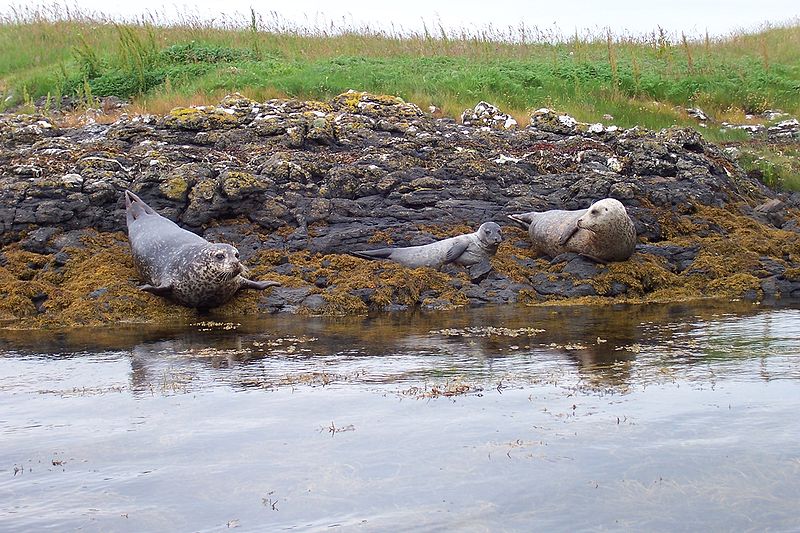
Grey seals can be seen around the Isle of Skye all year, but especially in fall and winter.
©Adam Cuerden – Public Domain
Common seals (Phoca vitulina) and grey seals (Halichoerus grypus) inhabit the waters encircling the Isle of Skye. They can be witnessed swimming or basking on rocks, depending on the season. Grey seals are a year-round resident, though they are more abundant during the breeding season that lasts from autumn to winter. Common seals are also present all year; however, their breeding season is in summer. The best areas to find seals on Skye are at Neist Point, Loch Dunvegan, and Kylerhea (an area on the southeastern side known for its seal population).
Grey seals range in weight from 550-880 pounds for males and 330-660 pounds for females. Their lifespans are generally 25-35 years. Common seals have a shorter average lifespan of 20-25 years and are also smaller in size. Adult males weigh around 330 pounds, while females weigh 220 pounds.
Grey seals are superior hunters, their swimming and diving skills allowing them to feed on mackerel, cod, and herring. Common seals also consume fish, but they tend to prefer more shallow depths than grey seals. Their diet also includes crustaceans and cephalopods.
Dolphins and Whales

Possible areas to spot minke whales on the Isle of Skye include Rubha Hunish, Waternish Point, and Glendale.
©Annie Leblanc/Shutterstock.com
Boat tours will provide visitors to the Isle of Skye the opportunity to possibly see whales or dolphins in its waters. Common dolphins and bottlenose dolphins can be viewed, and it’s not unheard of in the summer to witness a “super pod,” a group numbering from hundreds to thousands of dolphins, swimming together.
The species of whales one would most likely see are minke whales, present from May to October. Rare species that could be seen on a whale-watching tour include humpbacks, orcas, sei, sperm, northern bottlenose, fin, and long-finned pilot whales.
Conclusion
Whether you’re seeking opportunities to view amazing wildlife, revel in the natural beauty of awe-inspiring landscapes, or tour an ancient castle, the Isle of Skye is the go-to place for all of this and more. Go on a hike, tour the circumference of the Misty Isle by car, or take a boat tour of the amazing marine life. There’s so much to do and explore in this unique place.
Thank you for reading! Have some feedback for us? Contact the AZ Animals editorial team.

